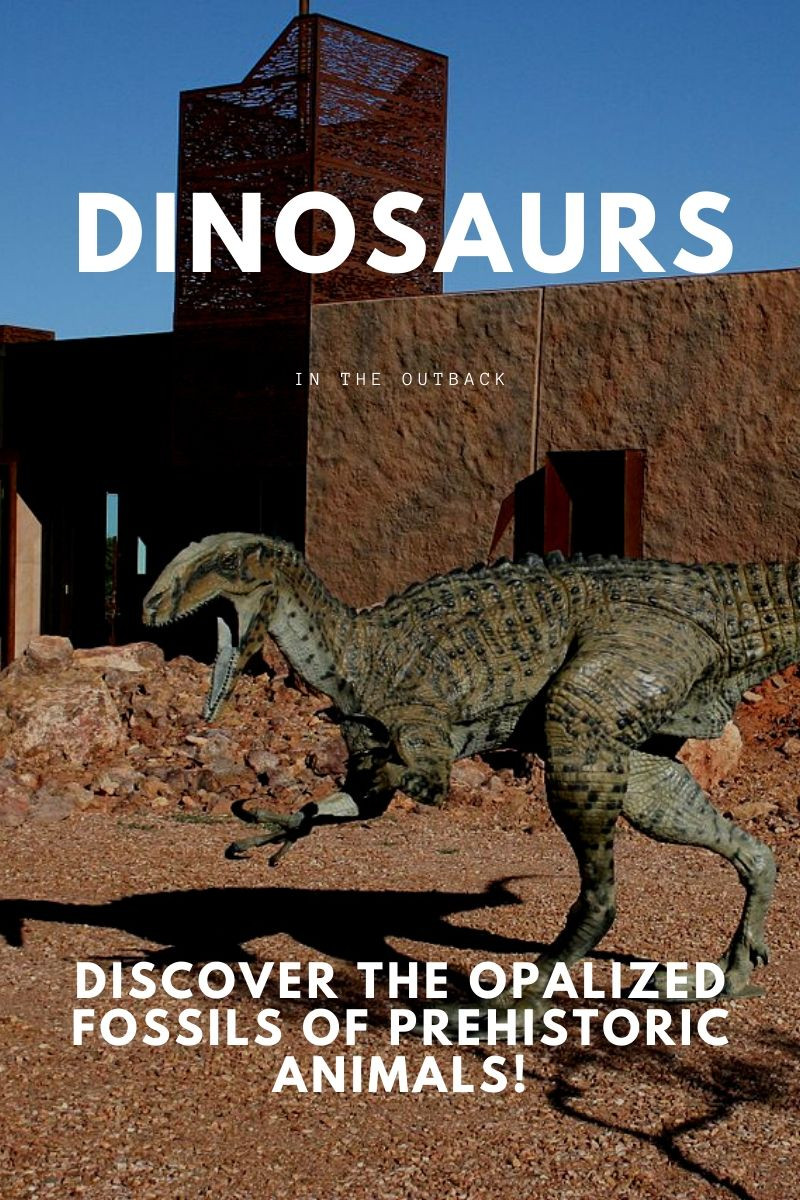
公開日27th Jul 2020
変更日時17th Nov 2025
先史時代の動物のオパール化石を発見しましょう!
 オーストラリアのアウトバックは刺激的な場所です。オパールの産地として有名であるだけでなく、時折、輝くオパールに覆われた古代の遺物が地表に現れることもあります。もしオーストラリア産オパールがアウトバックで採掘される唯一の宝物だと思っていたら、考え直してください。オパール採掘場で発見された、オーストラリア・アウトバックの壮大な動物化石をいくつか見てみましょう。
オーストラリアのアウトバックは刺激的な場所です。オパールの産地として有名であるだけでなく、時折、輝くオパールに覆われた古代の遺物が地表に現れることもあります。もしオーストラリア産オパールがアウトバックで採掘される唯一の宝物だと思っていたら、考え直してください。オパール採掘場で発見された、オーストラリア・アウトバックの壮大な動物化石をいくつか見てみましょう。
オーストラリアのアウトバックとは何ですか?
アウトバックは、オーストラリアの広大で険しい地形で知られる地域です。奥地という意味で、その名が付けられました。オーストラリア東部から西オーストラリア州の北部平原まで広がるこの内陸地域は乾燥しており、オパールの産地として最適です。
アウトバックには4つの大きな砂漠があり、ここでの主な産業は農業、石油、そしてオパール採掘です。しかし、1980年代にオパール採掘者が世界初となるオパール化した恐竜の骨格を発見するまでは、状況は一変しました。
オパールで覆われた骨格がどんなものか、想像できますか?真っ先に思い浮かぶのは、まるで別世界!これらの恐竜の骨は、まばゆいばかりのオパールで覆われており、世界で最も荘厳な骨と言えるでしょう。
さらに調査を進めると、研究者たちはオーストラリア平原を闊歩していたフォストリア・ディンバンガンマルと呼ばれる恐竜の新種を発見した。
しかし、アウトバックで発見されたオパール化した化石は恐竜だけではありません。
アウトバックの動物たち
アウトバックの動物たちというと、まるでアクション映画のように聞こえるかもしれません。それは、これらのオパール化した化石が、歴史に彩られたアクション満載の作品だからです。オパール化した化石のほとんどは、ニューサウスウェールズ州ライトニングリッジ鉱山で採掘されています。ここは、世界最大のブラックオパールの供給源となっている鉱山です。
緑、青、青緑、オレンジのネオンカラーの標本が、Play Of Color として知られる宇宙の銀河を思わせる燃えるような輝きでこれらの宝石を輝かせます。
これらの区画はどれも素晴らしいですが、中でも恐竜の化石は圧巻かもしれません。オパールは長年、世界で最も神秘的な宝石の一つと考えられてきましたが、今やジュラ紀の歴史に深く根ざしています。
1億年以上前、白亜紀前期には恐竜が地球を闊歩していました。そして今、その化石がオパールに覆われて地表に現れています。
これらの古代の動物たちの骨、貝殻、歯の残骸は、何百万年もの歳月をかけてオパールの化石へと変化しました。そして、なんとオーストラリアのアウトバックは、この自然の魔法を目にすることができる世界で唯一の場所です。
でも、これはトリックではありません。これは本物のオパールの化石なんです!一体どうやってこんなことが可能なのか、不思議に思うかもしれませんね。さあ、これらの化石の埃を払い落として、その歴史を紐解いてみましょう。
オパール化石はどのように形成されるのでしょうか?
古生物学者は、中国から北米に至るまで、世界各地で恐竜の化石を発掘してきました。しかし、これらのオパール化した化石の最も興味深い特徴は、それらが発見された土地です。
人間がオーストラリアの奥地でオパールを採掘するずっと前から、恐竜はアフリカ、南極、インド、南アメリカを繋ぐ超大陸を歩き回っていました。
数百万年前、この地の気候は穏やかで、現在の乾燥した埃っぽい地形とは対照的でした。超大陸を取り囲む無数の水路、河川、氾濫原から生まれた豊かな植生が、この地を覆い尽くしていました。
白亜紀には、大陸の3分の1を覆う浅い海がありました。この海底には、魚類、爬虫類、無脊椎動物など、多種多様な先史時代の海洋生物が生息していました。
その後の百万年の間に、動物や植物の堆積物は失われ、砂の層の下に埋もれていきました。
超大陸が広がるにつれて、シリカの結晶が地球の割れ目や裂け目に落ち、これらの化石を覆い、輝くオパールで覆われました。
その結果は?魚、鳥、哺乳類、そしてもちろん恐竜のオパール化した化石という先史時代の遺物です!
オパール鉱山で発見されたオーストラリア奥地の動物化石の興味深い発見をいくつか見てみましょう。
ベレムナイト
今日では、これらの化石オパールを現代のイカの体に例えるでしょう。しかし、実際には海生生物を支えていた貝殻のような物質です。まるで1970年代の燭台のように、きらめくネオンカラーの輝きに包まれています。最高です!
貝殻
数百万年前、海洋性腹足類は超大陸に広がる河口や湿地帯の両側に生息していました。今日では、色鮮やかなオパールに覆われた、非常に美しい貝殻の形をした遺物となっています。
馬の形をしたオパールの頭蓋骨
オパール化した恐竜の完全な骨格が発見され、馬の頭の形をしたオパール化した頭蓋骨も発見されました。
先史時代の植物
ライトニングリッジでは、毎年、鉱山労働者がオパール化した植物の化石を大量に採掘しています。これらの古代の遺物は、当時の動物や恐竜の食料となった先史時代の植物です。化石には茎、種子、松ぼっくりなどがあり、どれもオパールに輝いています。
軟体動物
アウトバックでは、腹足類と二枚貝という2種類の軟体動物と巻貝がよく見られます。かつては淡水に生息していたこれらの動物は、古水路や砂岩に沿って生息していました。
魚
アウトバックでは、次のようなさまざまな海洋生物がオパール化した化石として発見されています。
サメ - サメの歯は非常に珍しいですが、めったに発見されません。
肺魚 - ライトニングリッジで肺魚のオパール化石3個が発見された。
硬骨魚類 - 硬骨魚類の骨は表面に出ていますが、重い採掘機械に耐えるには脆すぎたり小さすぎたりすることがよくあります。
淡水ザリガニ(地元の人は「ヤビー ボタン」と呼ぶ)は、胃石と呼ばれるオパール化した貝殻です。
カエル - ライトニングリッジのクーコランフィールドで、オパール化した古代の顎骨が発見されました。
カメ - アウトバックでは、陸生種と沼生種のカメの化石が 3 種類発見されています。
ワニ - そうです、アウトバックで発見されたオパール化した化石の中にはワニの骨も含まれていますが、現在よりもずっと小さかったと考えられています。
プレシオサウルス
今日では、海生爬虫類または両生類と呼ばれています。しかし、数百万年前はプレシオサウルスと呼ばれていました。これらの遊泳爬虫類は、アザラシのように水しぶきを上げながら陸から淡水、そして海や川へと泳ぎ回っていました。鉱夫たちはオパール化した歯によく出くわしますが、骨を見つけるのは非常に稀です。
翼竜
白亜紀前期には、現代の鳥類は翼竜として知られていました。しかし、彼らは羽毛ではなく、空を飛ぶ爬虫類でした! 完全に絶滅したこの神秘的な生き物の唯一の痕跡は、彼らが残した化石であり、今ではオパールに覆われています。
恐竜
さあ、恐竜の話に戻りましょう!オーストラリアのアウトバックで発見された動物の中で最も興味深いのは、おそらくオパール化した恐竜の化石でしょう。中でも特に興味深いのは、竜脚類、鳥脚類、アンキロサウルス、獣脚類といった種の骨です。オーストラリア・オパール・センターには、背骨、歯、爪、肋骨、肩の骨、足の指の骨、四肢の骨など、オパール化した化石が数多く収蔵されています。
アウトバックの先史時代の宝物
オーストラリアのアウトバックは世界的に有名なブラックオパールの産地ですが、その地表の下には宝石以外にも多くのものが眠っています。オパール化した化石は、母なる自然の驚異的な魅力と神秘を物語る、まさに奇跡的な証です。次回オーストラリアを訪れる際は、アウトバックの色鮮やかな宝物の数々にぜひご注目ください!
オーストラリアには、クイーンズランド州ウィントンのオパールフィールド地域とニューサウスウェールズ州ライトニングリッジの 2 つの恐竜博物館があります。
ウィントン
ウィントンはブリスベンから車で15時間の場所にあり、有名なオーストラリア恐竜時代博物館と、恐竜スタンピードを含む恐竜トレイルの本拠地です。博物館を出発し、骨や遺物を展示するツアーが毎日開催されており、化石準備室の見学も含まれます。移動式シャトルバスが、名所やスタンピード後に残された驚くべき足跡へとご案内します。2021年には、高性能望遠鏡を備えた宇宙観測所が一般公開されます。夜は真っ暗で、星空観察に最適です。
クイーンズランド博物館では毎週恐竜発掘イベントを開催しており、9500万年もの間埋もれていた恐竜の骨を発掘する興奮を体験できます。また、発掘した標本に漆喰を塗って、博物館の化石準備室への見学に備えることもできます。料金は1週間で3700ドルで、宿泊と食事が含まれます。これらの恐竜発掘イベントの資金は恐竜研究に役立てられており、定員に限りがあるため、1年前からの予約が必要です。 
2015 年に恐竜の発掘現場を見学するセダ・オパール社のポール・セダウィー氏。ウィントンを訪れると、オパール採掘場まで車で行くことができ、一部のエリアは化石採掘のために確保されています。
ライトニングリッジ
2020年にライトニングリッジに2階建てのオーストラリア・オパールセンターを建設する承認が下りた。この博物館では、恐竜から貝殻、ムール貝まで、希少な化石オパールが展示される。恐竜の骨は珍しいが、オパール化した色彩は息を呑むほど美しい。ライトニングリッジはかつて古代の内海の海底であったため、オパール採掘者は時折、恐竜の骨や歯、植物、肺魚から亀の骨、鳥類に至るまでの海洋生物を発見する。1980年代に発見された新種フォストリア・ディンバンガンマルを含む恐竜の群れは、世界で最も完全なオパール化した恐竜の骨格である。 
最新のオーストラリア切手には白亜紀の化石が描かれており、ライトニングリッジの獣脚類の歯がオパール化したものも掲載されている。
オパール化石を買う
Opal Encyclopedia検索
最新記事
ブラックオパールは、オパールの中でも最も人気のある種類です。深いベースが表面に虹色の輝きを放ちます。ブラックオパールの用途、特性、歴史、そして価値についてご紹介します。
7th Dec 2025
オパールの等級付け方法と価格に影響を与える要因をご紹介します。色や輝き、カットや産地など、それぞれのオパールの価値がどのように評価されるのか、価格帯の例とともにご紹介します。
19th Jul 2023
記事のカテゴリ
All there is to know about Opals including Black Opals, Ethiopian Opals & Boulder Opal
14記事数
Check out our fascinating information and articles on all things amazing in the Opal world
41記事数


